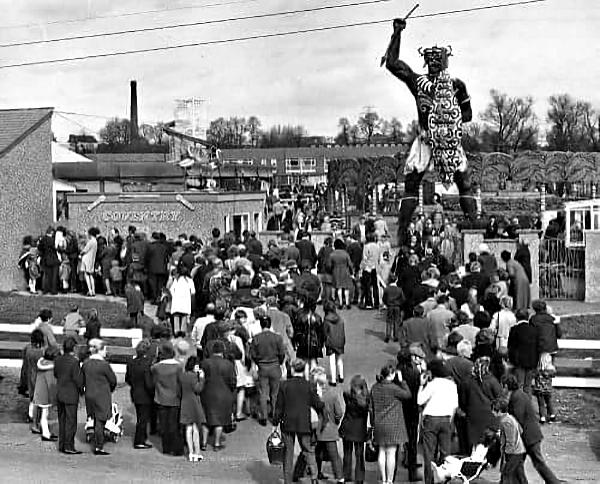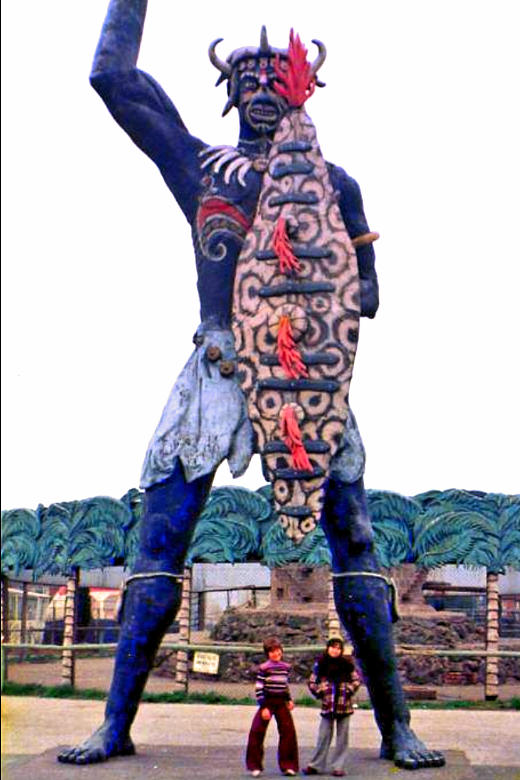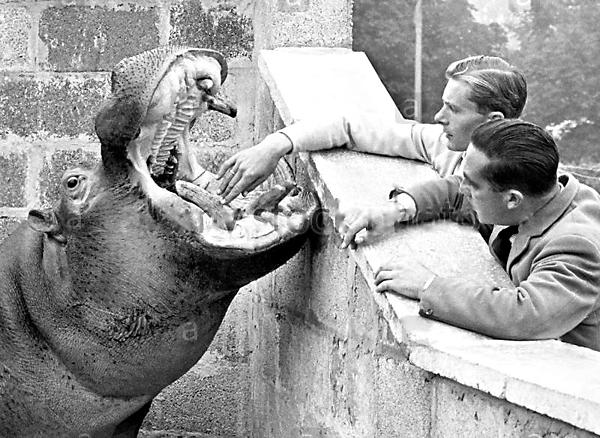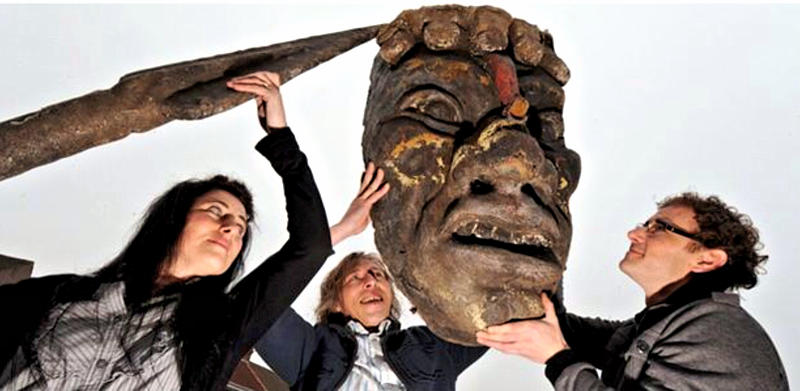|
Index...
|

 n 1966 I was living in Willenhall, and my first full time job was at the Coventry Zoo at Whitley. I was 16, just leaving Whitley Abbey school. I already had a place at the Coventry College of Art on the only course you could start at 16 years old. The summer holiday job at the Zoo was going to give me a bit of pocket money before I start in September 1966. I got the job through a school friend, Dave Wood, who had already got a weekend job there. Dave said that the zoo had been set up as a wedding type present from two sides of two families - one being the Chipperfield of Chipperfield Circus fame, and the Richmond or the Banks family of pork pie fame! I was never sure of this fact, but it did make sense as there were so many ex-circus animals in the zoo. Dave did not want full time work at the zoo as he was going to work at Rolls Royce engines, Parkside, along with his father who had put his name down for an apprenticeship.
n 1966 I was living in Willenhall, and my first full time job was at the Coventry Zoo at Whitley. I was 16, just leaving Whitley Abbey school. I already had a place at the Coventry College of Art on the only course you could start at 16 years old. The summer holiday job at the Zoo was going to give me a bit of pocket money before I start in September 1966. I got the job through a school friend, Dave Wood, who had already got a weekend job there. Dave said that the zoo had been set up as a wedding type present from two sides of two families - one being the Chipperfield of Chipperfield Circus fame, and the Richmond or the Banks family of pork pie fame! I was never sure of this fact, but it did make sense as there were so many ex-circus animals in the zoo. Dave did not want full time work at the zoo as he was going to work at Rolls Royce engines, Parkside, along with his father who had put his name down for an apprenticeship.
I worked every day of the week but had Wednesday afternoons off. This was all for £5 a week (I got to eat as many bananas as I liked but it did put me off them for years afterwards). My job each morning was to clean out and feed mainly the paddock animals - that's the Zebra, Deer, Wallabies, Kangaroo, Ostriches, Baboons, Rhesus Monkeys, Porcupines, Vultures, Eagles, and many other small animals in the children's Ark.

The best job was twice a day, at 11am and 2pm, when I fed the three Sea lions. Before feeding I had to wash and gut the fish and cut them in half, taking them in a large metal bucket to the Seals' Pool which was a round pool with a small wooden house in the island in the middle. Around the pool was an area of grass, but before this was an electric fence to keep the seals from escaping. At feeding time, which was watched by many people, I would cross over the electric fence and stand by the pool-side and call them - the aim was to get them to do some exercise. When they swam close I would throw the fish as far away as I could, which they had to chase for. Then I would call them back and repeated it over and over until they all got about the same amount of fish. One day another school friend, also called Dave, came and visited me. It was a cold rainy day and no-one was around, so I let him have a go. I told him what to do, but he only called over the Sea lions, he did not throw the fish - he just held it out, up high, so they had to jump up to grab it. Of course, they also grabbed the ends of his fingers - but it was not too bad, they had only stripped a bit of skin off them! He would not listen to instructions and had to go home with poorly fingers.
After clearing out and feeding your own assigned animals, you were expected to help with other jobs around the zoo. This could be different every day, like washing the Elephant or doing some gardening. One of the big jobs every week was to drain and clean out the various pools - the Sea lion pool, Polar bear pool, and the pool that got most dirty - the Hippo's pool. He was called 'Harry', he had been a circus animal act, and he would open his mouth for food, mainly loaves or cabbages, when the keeper called out 'Harry Up'. This was a job I also sometimes got a go at. I would call 'Harry Up' and his big mouth would open but you could see he had very bad ulcers on his tongue and gums, which made him very cross. It did not help one day when he was rubbing his poor mouth up and down a row of iron bars on the gate - he got stuck and panicked, pulling out one of his tusks. The vet had to come and see him and gave us a spray that would help with his infection and relieve the pain.
'To clean out the Hippo pool'; this was the plan. The head-keeper would go into the Hippo's house / sleeping shelter, then pass through it into the compound, then call 'Harry', who would be sitting in the dirty water. Harry would get out and chase the head-keeper, who would quickly get out through the back door of the shelter. Closing the back gate across, the Hippo would follow him into the house and the keeper would taunt him through the gate. While this was happening, I would then jump over the compound wall and run over to the steel door of the Hippo's house and quickly close him in, and put the three bolts across. I would do this every week for about five weeks, until one day I was working in the zoo weeding one of the ground's many rose beds. It was very hot in the summer sun, and still wearing my cow-gown I got heat stroke and had to be taken home.

A day later, after I was taken ill, I was still off work. I heard on the national news that my zoo work-mate Richard McCormick, who was a year older than me, had been attacked by Harry the Hippo. Richard had not been as quick as I was, and the Hippo had backed out of his house as the door was being closed. His two-ton weight had hit Richard, knocking him to the ground. Then Harry had picked him up in his mouth and jumped in the muddy pool with Richard still in his mouth. Quick thinking head-keeper, John Vose, grabbed a stick and called 'Harry up', which made Harry open his mouth and Richard fell out into the water - then waving the stick and standing in the compound he challenged the Hippo. Harry the Hippo got out of the water and John kept him at bay, slowly backing into the Hippo house again. This gave Richard time to climb out of the water with a broken shoulder, many ribs broken, and a puncture wound in his side by a tusk. The zoo staff rushed Richard in the zoo manager's Jaguar car to Coventry and Warwickshire hospital.
I sometimes wonder if that could have been me? I do remember that the very last time I had closed the Hippo's steel door I'd only just got the top bolt across when the Hippo backed up onto the door, making it bow out at the bottom, and thinking 'that was a bit close'! He was starting to learn the trick we were playing on him!
All this happened before the Zulu statue was put at the front of the entrance to the zoo. I understand that when the zoo closed in the 1980s, the Zulu, which was made of chicken wire covered in fibreglass on a metal support frame, was taken as scrap to Freddie Barnes's scrapyard and lay on the ground where it collapsed on itself. It lay there until Debbie Mann and brother Gary, with Wayne Anderson, found its head, spear and big toe while looking for spare parts for an old Hillman Minx! They took it to a 'Real Deal' TV show in 2011 and David Dickinson advised that they look for a new home. They had a few offers but I'm not sure what happened to it. Most likely sold on eBay!

Website by Rob Orland © 2002 to 2026